Mumbai, the bustling metropolis on the west coast of India, is home to a diverse range of flora and fauna. In addition to its concrete jungles, there are beautiful natural spaces in and around the city, which provide ample habitat for various bird species.
Mumbai boasts of a rich bird diversity with over 350 species recorded in and around the city. From the common and noisy house crow to the exquisite Purple Sunbird, Mumbai’s avian population is a reflection of the city’s vibrant and eclectic character.
This article explores the different species of birds that inhabit the city and the important role they play in maintaining a balance in the urban ecosystem.
1. Rose-Ringed Parakeet
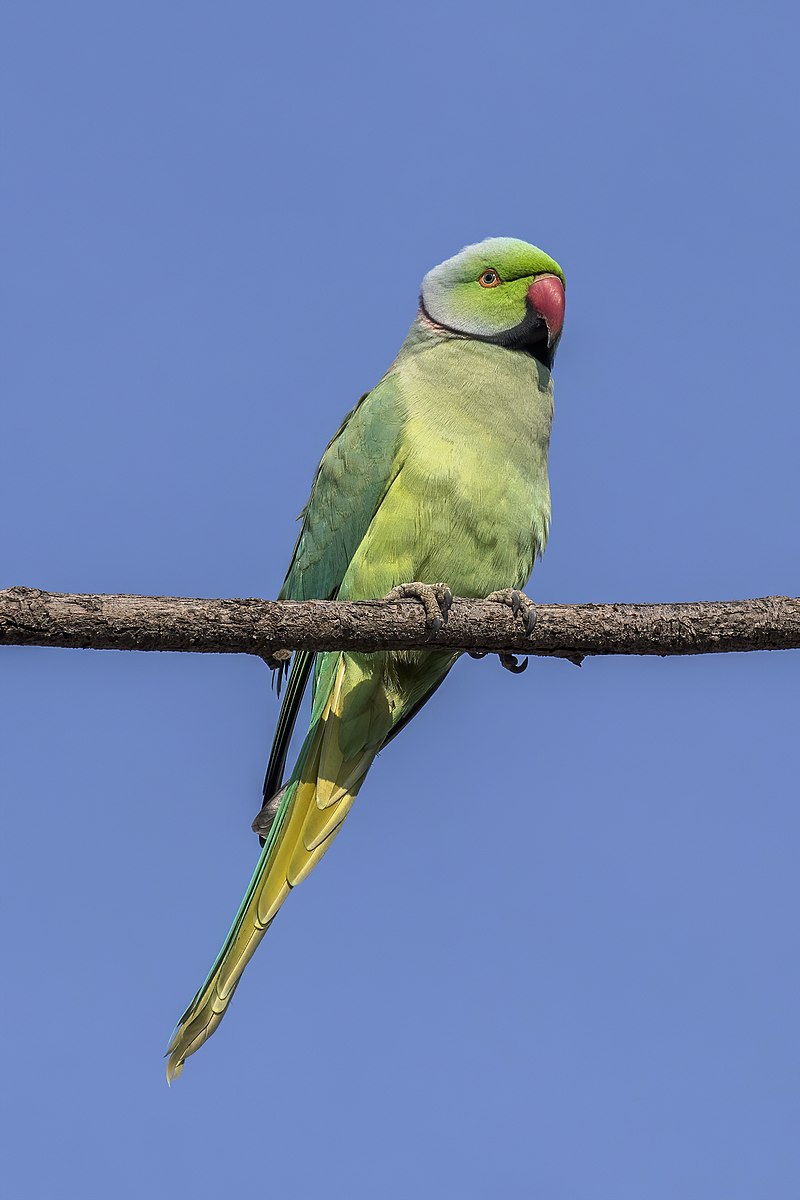
The Rose-ringed parakeet is a medium sized bird in the family Psittacidae. Native to Africa and India, it has been introduced into many other parts of the world where feral populations have now established themselves.
The most distinctive feature of this species is its colorful neck ring ranging from pink to purple which gives them their name.
However, males often display more vibrant colors than females do. This beautiful bird can also imitate human speech quite well making them popular pets worldwide.
In addition they are very social creatures preferring large flocks when out in nature or as part of aviaries during captivity. With proper care these birds can live up to 30 years.
Scientific classification:
| Kingdom | Animalia |
| Phylum | Chordata |
| Class | Aves |
| Order | Psittaciformes |
| Family | Psittaculidae |
| Genus | Psittacula |
| Species | P. krameri |
Also Featured In: Common Birds in India, Common Birds in the Cities
2. Asian Koel
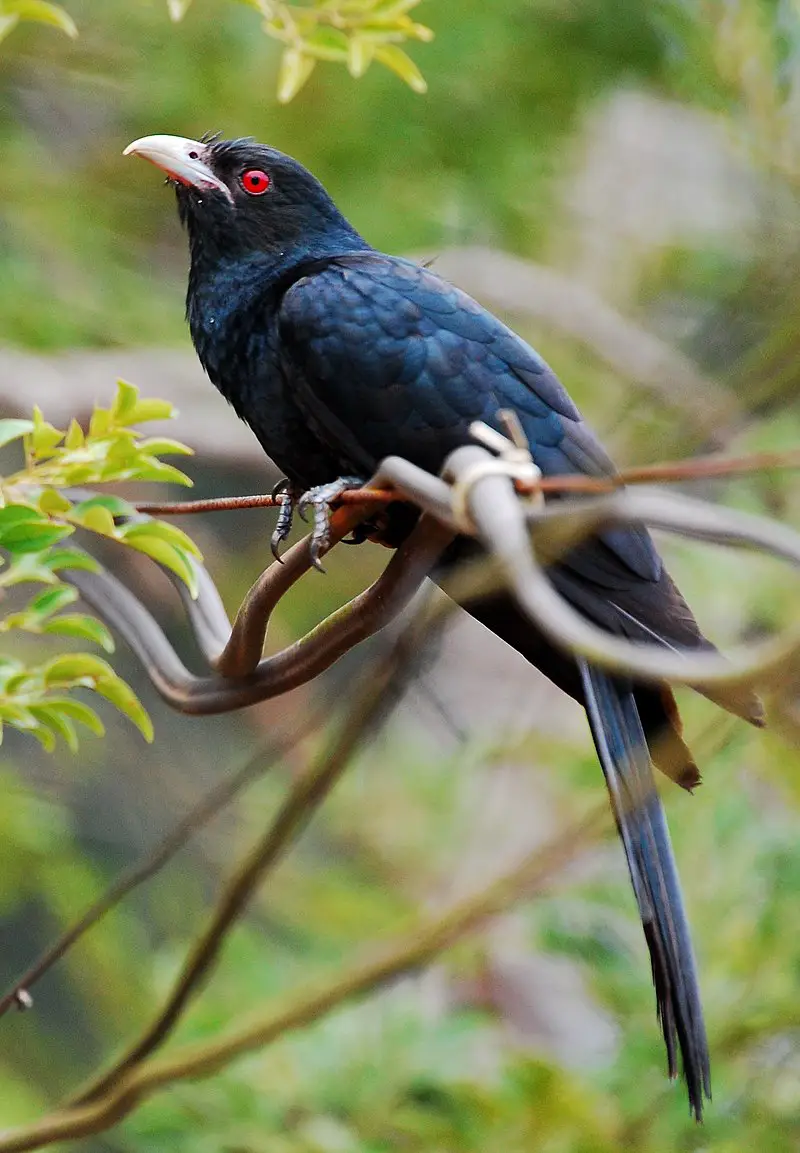
The Asian koel is a member of the Cuculiformes family, found in India, China and Southeast Asia. It shares its range with two closely related species – black-billed koels and Pacific koels.
This bird exhibits brood parasitism; it lays its eggs in nests of other birds, who then unknowingly become foster parents to their young.
Characterised by long tails and glossy feathers that vary from deep blue to greenish-black depending on region, these birds are known for their loud call which can be heard during both day or night time.
They feed mainly on fruits but also take insects when available.
All in all, the Asian Koel is an interesting species that has adapted itself well over many centuries within different ecosystems across Asia.
Scientific classification:
| Kingdom | Animalia |
| Phylum | Chordata |
| Class | Aves |
| Order | Cuculiformes |
| Family | Cuculidae |
| Genus | Eudynamys |
| Species | E. scolopaceus |
Also Featured In: Hong Kong Birds You Need to See, Birds of Goa
3. White-Throated Kingfisher
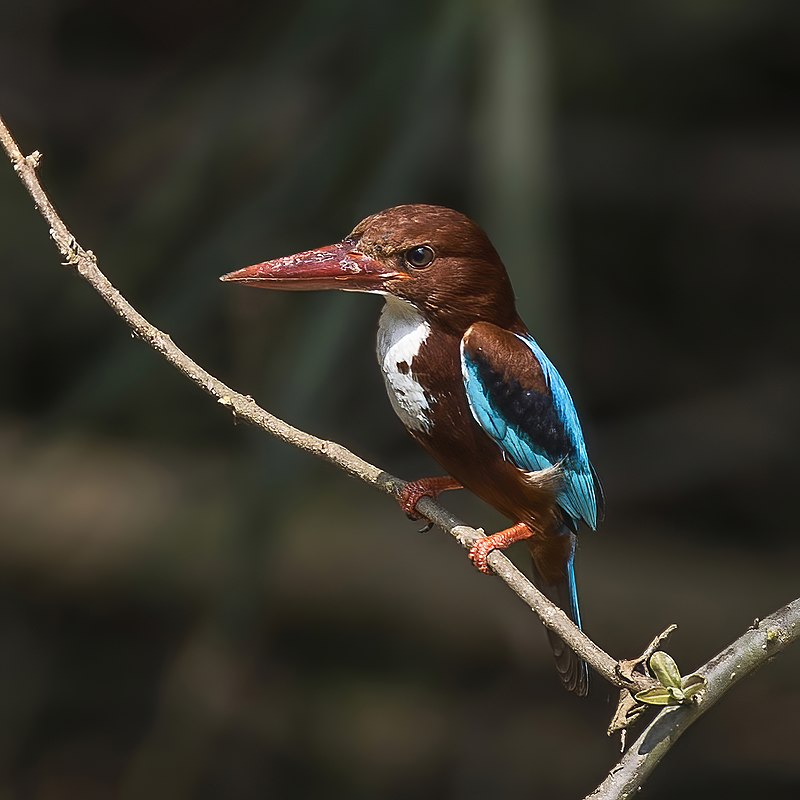
The White-throated Kingfisher is a beautiful bird with bright colors and distinct features. Its back, wings and tail are a deep blue while the head, breast, throat and belly are white.
It has two black stripes across its eyes which contrast nicely against its orange beak and feet.
These birds can often be found perching on tree branches or hovering over creeks in search of food like fish or small insects such as grasshoppers or crickets.
They use their sharp bill to pluck prey from water surfaces then swallow them whole after making adjustments for size by beating it against rocks if necessary.
The White-throated Kingfisher breeds during monsoon season when rainfall increases levels in rivers leading to an abundance of aquatic life that these birds love so much.
Scientific classification:
| Kingdom | Animalia |
| Phylum | Chordata |
| Class | Aves |
| Order | Coraciiformes |
| Family | Alcedinidae |
| Subfamily | Halcyoninae |
| Genus | Halcyon |
| Species | H. smyrnensis |
Also Featured In: Turkey Birds You Should Know, Lebanon Birds Live in Semi-Desert Areas
4. Oriental Magpie-Robin
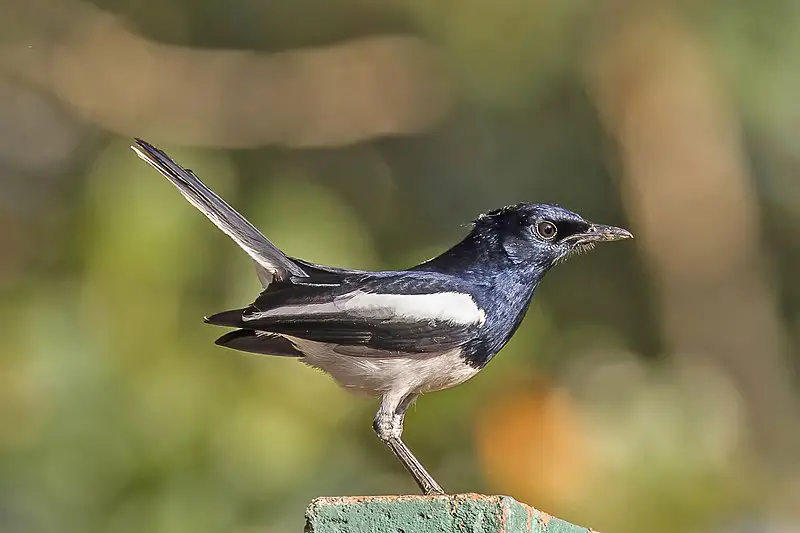
The Oriental magpie-robin is a beautiful passerine bird found across the Indian subcontinent and parts of Southeast Asia.
It can be easily identified by its black and white plumage, long tail that it holds upright while perched or foraging on the ground.
They are known to sing melodiously which makes them popular as cage birds in many countries.
These birds feed mainly on insects but also consume fruits, berries and nectar from flowers during certain times of the year.
Their population numbers have been declining due to destruction of their natural habitats like deforestation.
However, conservation efforts have seen some success in recent years with more areas being set aside for protection and preservation.
Scientific classification:
| Kingdom | Animalia |
| Phylum | Chordata |
| Class | Aves |
| Order | Passeriformes |
| Family | Muscicapidae |
| Genus | Copsychus |
| Species | C. saularis |
Also Featured In: Most Common Types of Bangladeshi Birds, Black And White Birds You Don’t Know About
5. Coppersmith Barbet
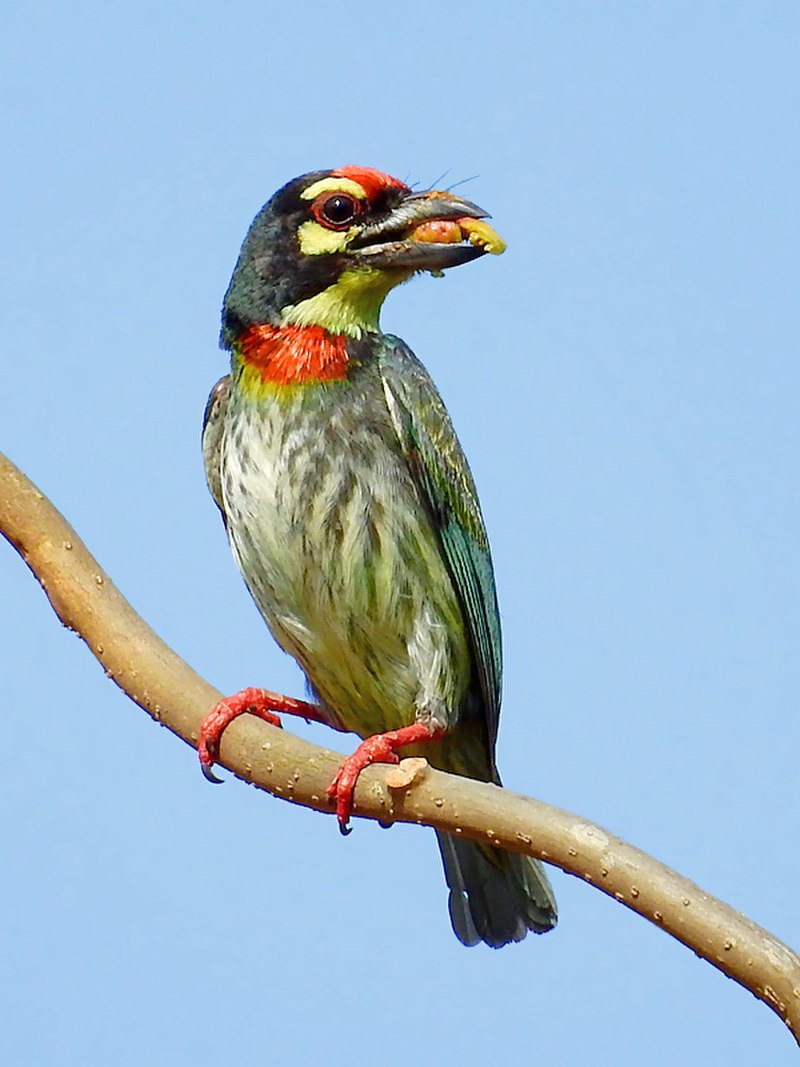
The Coppersmith barbet is an attractive Asian bird, easily recognizable by its bright crimson forehead and throat.
It has a call that sounds like a coppersmith striking metal with a hammer – hence its name.
These birds are found in the Indian subcontinent and parts of Southeast Asia where they build their nests inside trees, carving out holes for themselves.
They can often be seen perched high up on trees or wires during the day as they feed on fruit from nearby branches.
The vibrant colors of these birds make them stand out amongst other species in their habitat.
Scientific classification:
| Kingdom | Animalia |
| Phylum | Chordata |
| Class | Aves |
| Order | Piciformes |
| Family | Megalaimidae |
| Genus | Psilopogon |
| Species | P. haemacephalus |
Also Featured In: Birds That Live in the Jungle, Birds that Live in Tamil Nadu
6. Common Tailorbird
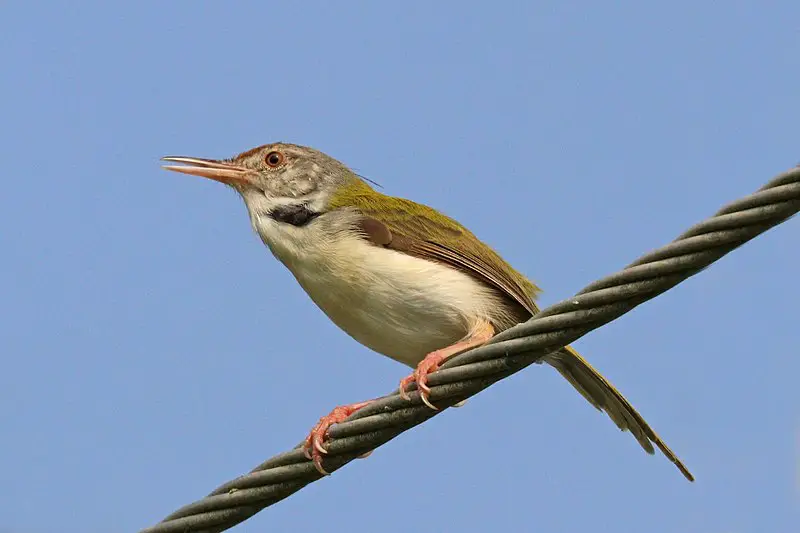
The Common Tailorbird is a songbird found across tropical Asia, popular for its unique nests made of leaves “sewn” together.
It was immortalized by Rudyard Kipling in his Jungle Book as Darzee and can often be seen in urban gardens.
Though shy birds that are usually hidden within vegetation, their loud calls give away their presence.
They are distinctive with a brownish plumage on the upperparts and paler gray underparts; white throats speckled black mark them out from other similar species.
They feed mainly on insects such as spiders, caterpillars and grasshoppers but will also eat fruit when available.
Breeding season begins around March or April with males singing to claim territories before beginning to weave intricate leafy structures for nesting sites – an amazing feat.
All in all these delightful little birds make wonderful additions to any garden setting – just remember not to get too close.
Scientific classification:
| Kingdom | Animalia |
| Phylum | Chordata |
| Class | Aves |
| Order | Passeriformes |
| Family | Cisticolidae |
| Genus | Orthotomus |
| Species | O. sutorius |
Also Featured In: Urban Birds of Hong Kong, Birds That Live In Phuket Island
7. Red-Vented Bulbul
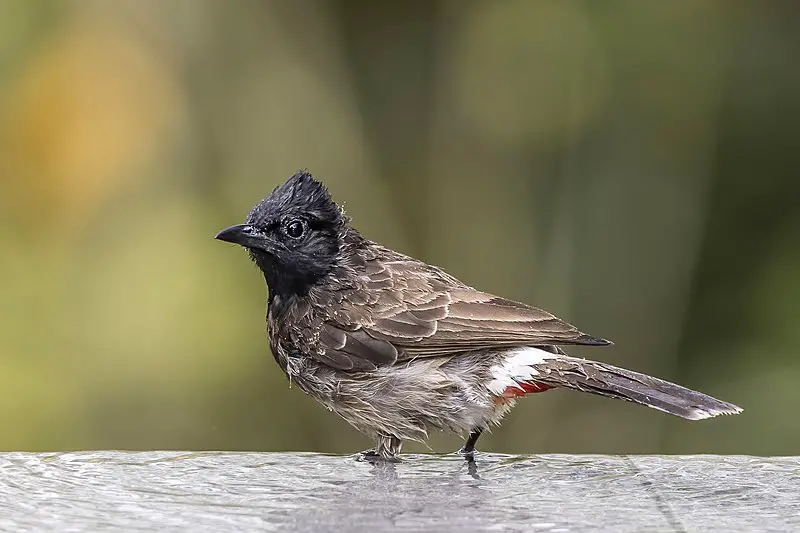
The Red-vented Bulbul is an impressive bird native to the Indian subcontinent, and has been introduced to regions around the world.
It belongs to the bulbul family of passerines and is a resident breeder in many countries including Sri Lanka, Burma, Bhutan and Nepal.
It also thrives in New Zealand, Argentina, Tonga and Fiji as well as parts of Samoa, Australia USA and Cook Islands.
This species has grey heads with white cheeks that contrast sharply against their black wings with bright red vent feathers which give them their name.
They typically live near woodland areas where they can forage for fruits or small insects on trees or bushes; this makes them useful birds for controlling insect populations naturally.
The male red-vented bulbuls are renowned songsters who sing out from treetops at dawn each day – adding some beautiful melodies to any garden.
Scientific classification:
| Kingdom | Animalia |
| Phylum | Chordata |
| Class | Aves |
| Order | Passeriformes |
| Family | Pycnonotidae |
| Genus | Pycnonotus |
| Species | P. cafer |
Also Featured In: Birds of Myanmar, Birds that Live in Tahiti Island
8. Red-Whiskered Bulbul
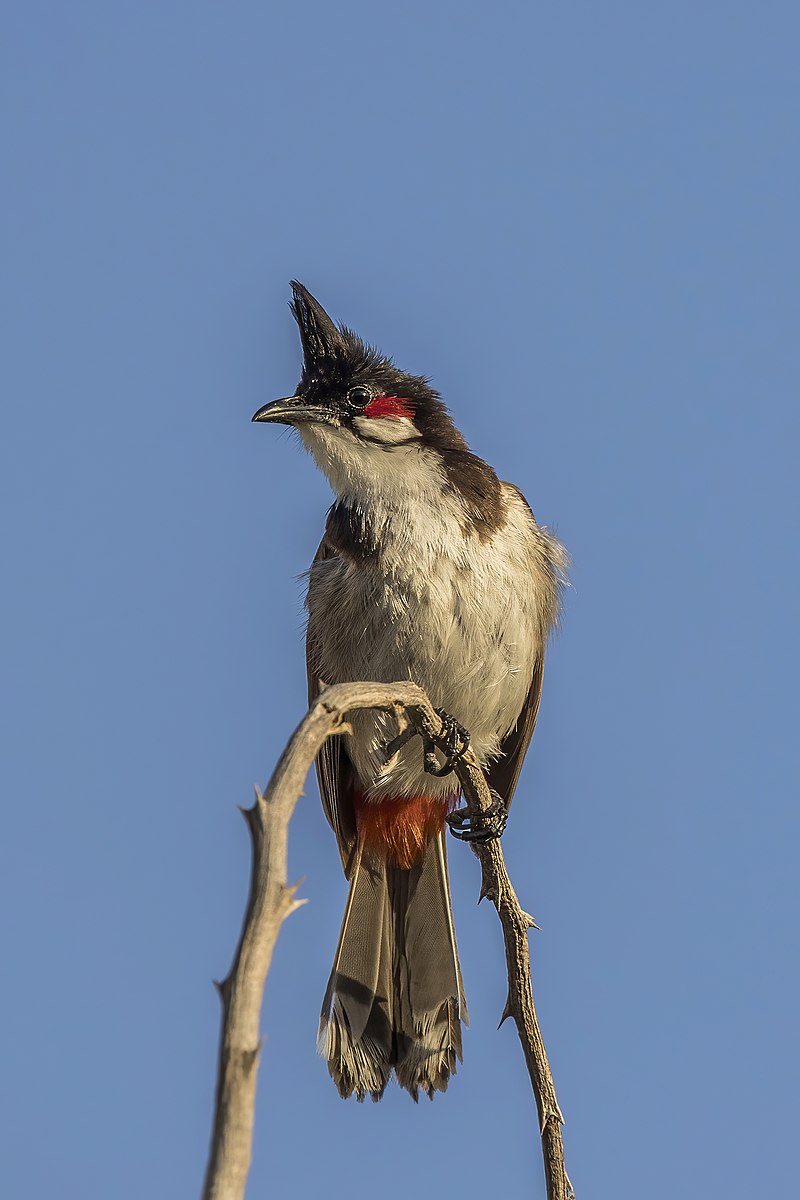
The Red-whiskered Bulbul is a passerine bird native to tropical Asia. It has an unmistakable black head, white cheek patch, and red whiskers on each side of its beak.
This brightly colored bulbul feeds mainly on fruits but also eats small insects from time to time.
The birds are known for their loud call which consists of three or four notes in succession and can often be heard emanating from treetops or other high perches where it likes to sit conspicuously.
Introductions have been made in many parts of the world outside its original range, with populations establishing themselves successfully in various locations including Hawaii and Florida within the United States.
Scientific classification:
| Kingdom | Animalia |
| Phylum | Chordata |
| Class | Aves |
| Order | Passeriformes |
| Family | Pycnonotidae |
| Genus | Pycnonotus |
| Species | P. jocosus |
Also Featured In: Common Birds in Kerala, Birds that You’ll Find in Kolkata
9. Eurasian Golden Oriole
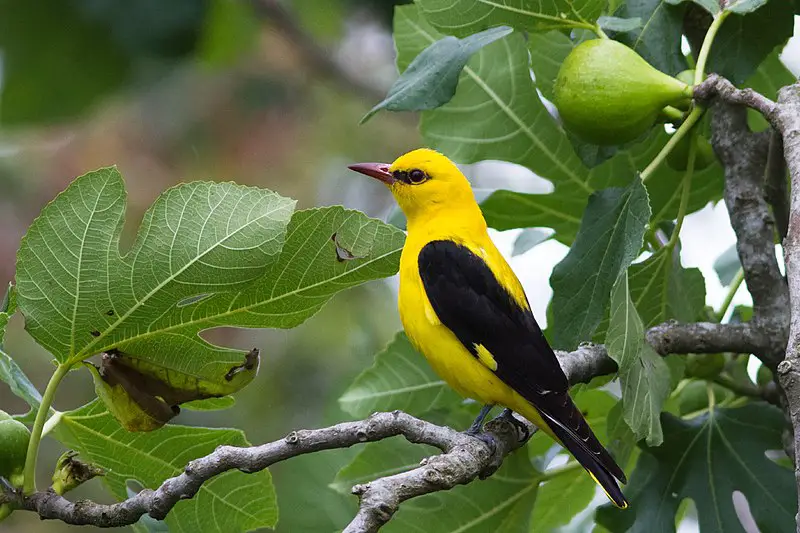
The Eurasian golden oriole is a beautiful bird belonging to the Old World oriole family of passerine birds that breed in temperate climates of the Northern Hemisphere.
It migrates from Europe and Palearctic during summer season, and spends its winter months in central and southern Africa.
These birds have an impressive range with large populations which appear to be stable or increasing across much of their range due to conservation efforts.
They are mostly found near forests, woodlands, riverbanks and meadows where they feed on fruits as well as insects such as caterpillars, beetles, grasshoppers etc.
The males can easily be identified by their bright yellow plumage while females are more olive coloured.
All in all these stunningly colourful creatures add vibrancy to our environment.
Scientific classification:
| Kingdom | Animalia |
| Phylum | Chordata |
| Class | Aves |
| Order | Passeriformes |
| Family | Oriolidae |
| Genus | Oriolus |
| Species | O. oriolus |
Also Featured In: Most Beautiful birds of Greece, Ukrainian Birds You Should Know
10. Tawny Pipit
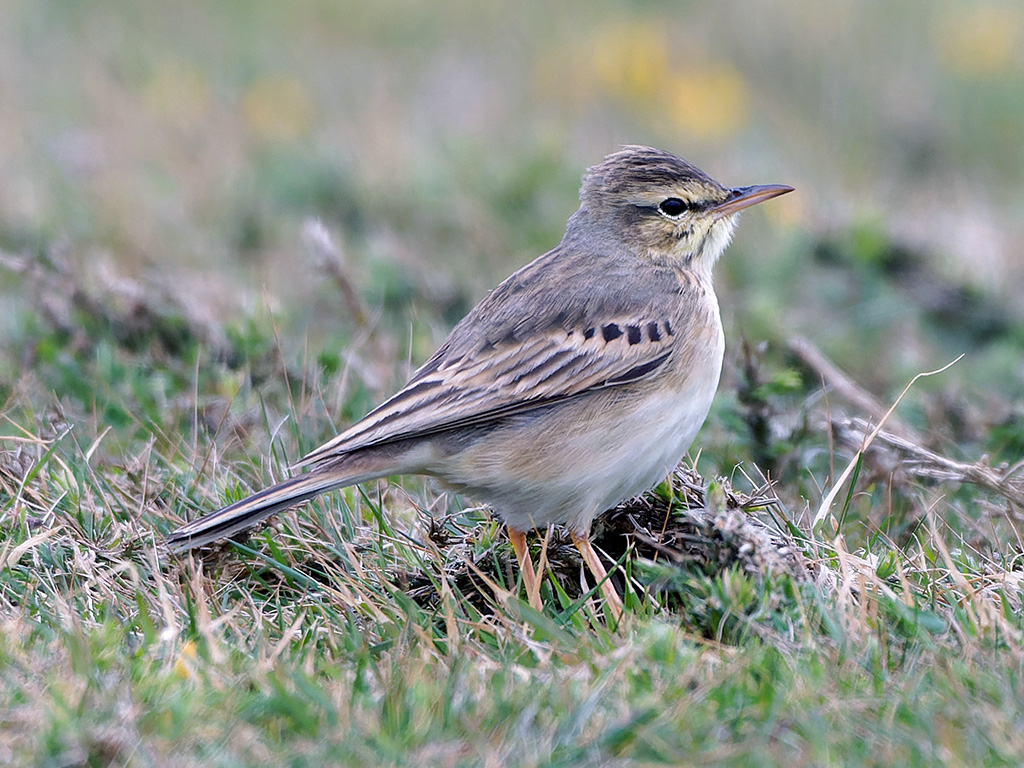
The Tawny Pipit is a medium-large passerine bird that breeds across much of the central Palearctic region.
It has an impressive range, stretching from northwest Africa and Portugal to Central Siberia and Inner Mongolia.
During winter months it migrates southwards to tropical Africa and India where it spends its time in grasslands.
Its scientific name ‘Anthus campestris’ comes from Latin; Anthus meaning ‘smallbird’, while Campestris means “of open country or fields”.
The Tawny Pipit displays bold streaks on its back with sandy brown upper parts which blend into white underparts.
It can be identified by its distinctive song too – consisting of several rising notes followed by one lower trill note at the end.
Scientific classification:
| Kingdom | Animalia |
| Phylum | Chordata |
| Class | Aves |
| Order | Passeriformes |
| Family | Motacillidae |
| Genus | Anthus |
| Species | A. campestris |
Also Featured In: Andorra birds, Common Slovakian Birds
11. Alexandrine Parakeet
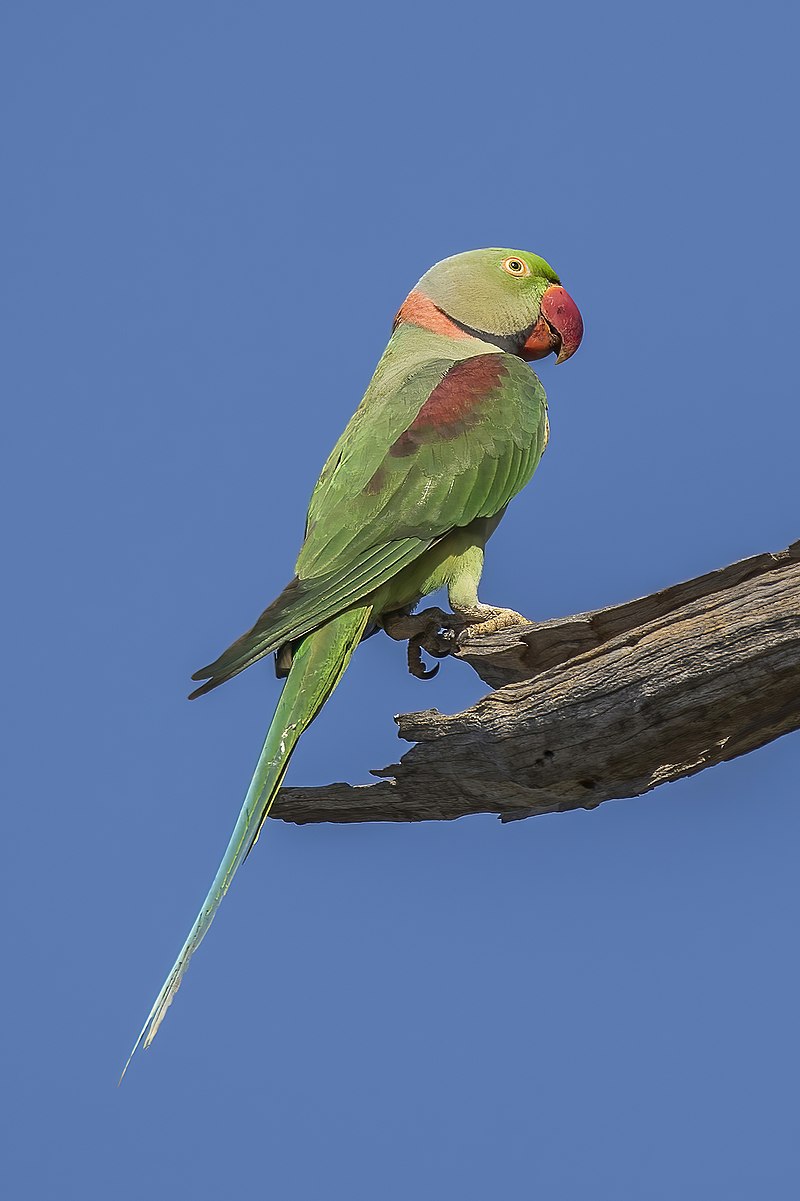
The Alexandrine parakeet is a medium-sized parrot belonging to the Psittacula genus. It is named after Alexander the Great.
Alexander transported many of these parakeets from Punjab to various countries in Europe and the Mediterranean, where they were highly valued by royalty, nobility, and warlords.
They are also known as Alexandrine parrots.
Scientific classification:
| Kingdom | Animalia |
| Phylum | Chordata |
| Class | Aves |
| Order | Psittaciformes |
| Family | Psittaculidae |
| Genus | Psittacula |
| Species | P. eupatria |
Also Featured In: Birds That You’ll See in Kaziranga National Park, Delhi Birds You Need to See
12. Purple-Rumped Sunbird
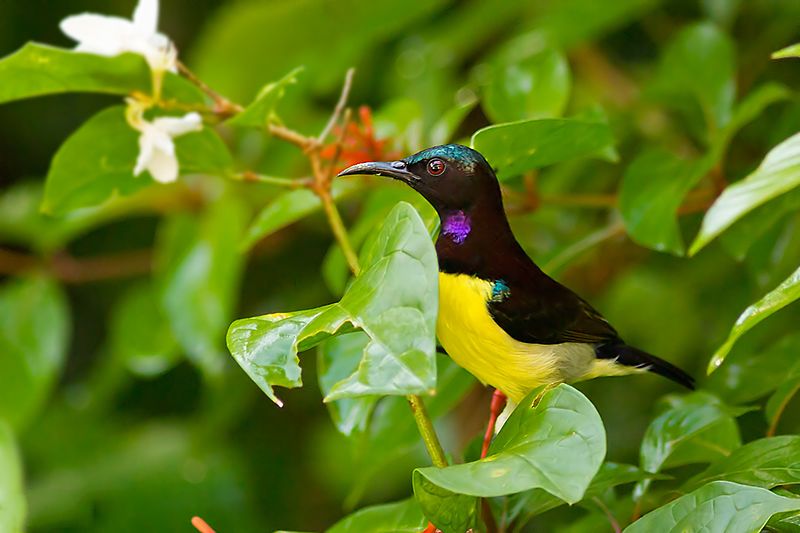
The Purple-rumped sunbird is a tiny bird found exclusively in the Indian Subcontinent. They primarily consume nectar but also have insects as a part of their diet when feeding young ones.
These birds can hover for a brief period, but they usually settle on a branch or flower to drink nectar. In addition, they create hanging pouch nests using cobwebs, lichens, and plant materials.
The males have a unique purple patch on their rump, making it easy to distinguish them from the female. These tiny birds are a delight to observe and a crucial part of the ecosystem.
Scientific classification:
| Kingdom | Animalia |
| Phylum | Chordata |
| Class | Aves |
| Order | Passeriformes |
| Family | Nectariniidae |
| Genus | Leptocoma |
| Species | L. zeylonica |
Also Featured In: Pet Birds that Live in India,
13. Greater Short-Toed Lark
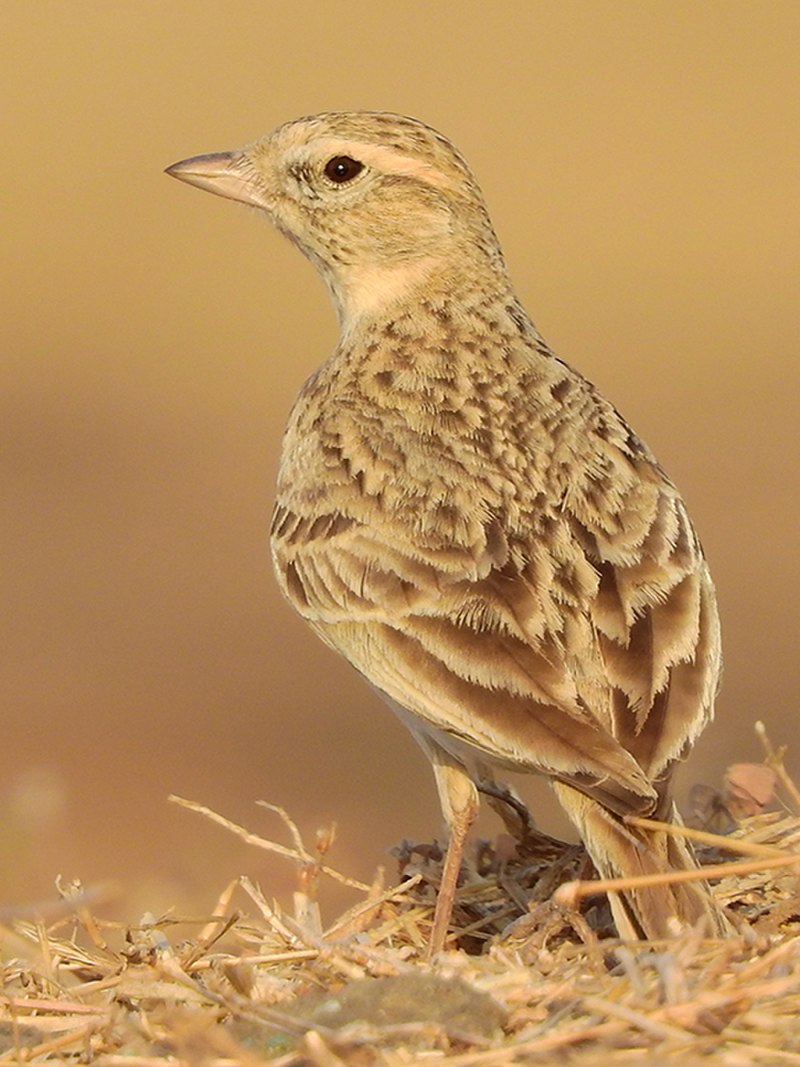
The Greater short-toed lark is a small bird found in Southern Europe, north-west Africa, and across the Palearctic from Turkey to Mongolia.
Its scientific name comes from Greek, with Calandrella meaning a smaller version of the Calandra lark and brachydactila indicating short toes.
This passerine bird is known for its distinctive short toes, which give it excellent balance and make it well-suited to life on the ground.
During breeding season, the Greater short-toed lark is known for its beautiful song, which can be heard as it flies overhead.
Despite its relatively small size, this bird is a skilled hunter, feeding primarily on insects and other small invertebrates.
Overall, the Greater short-toed lark is a fascinating bird with a unique set of adaptations that make it well-adapted to life in its various habitats.
Scientific classification:
| Kingdom | Animalia |
| Phylum | Chordata |
| Class | Aves |
| Order | Passeriformes |
| Family | Alaudidae |
| Genus | Calandrella |
| Species | C. brachydactyla |
Also Featured In: Most Popular Birds in Mallorca,